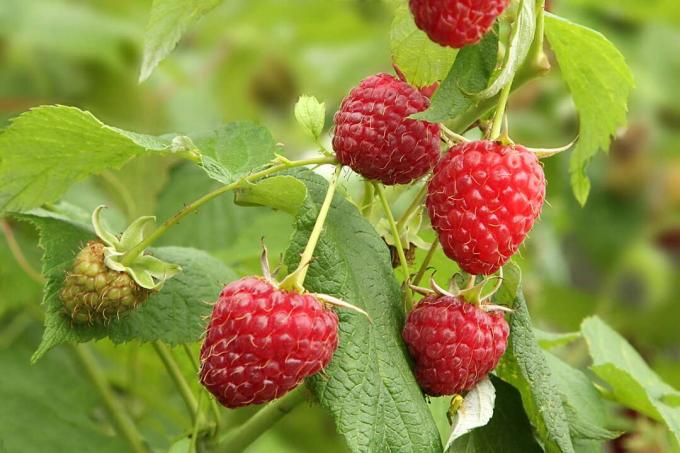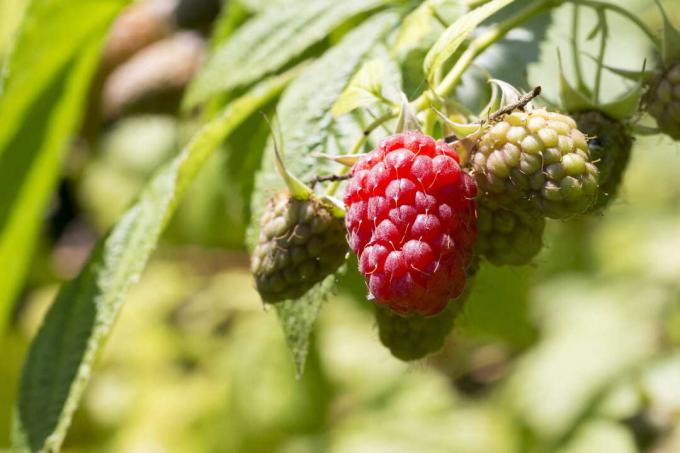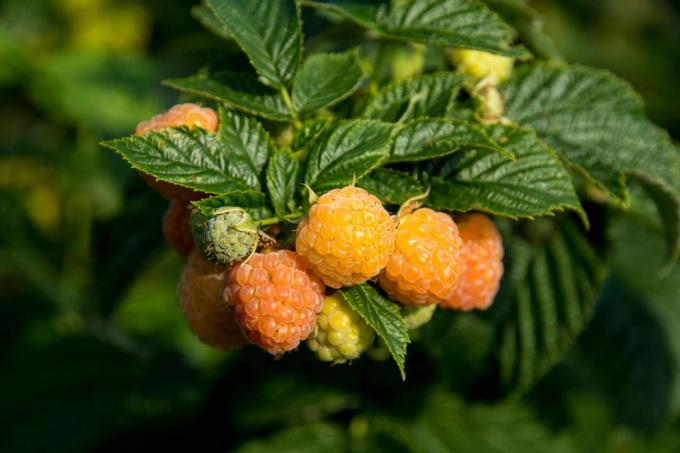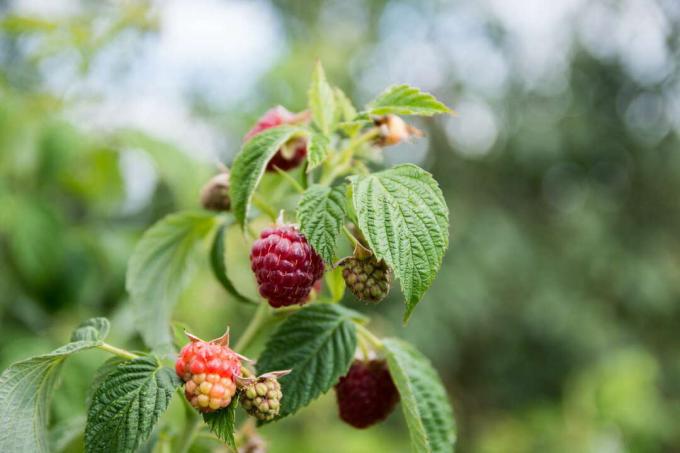The delicious, small raspberries should not be missing in any home garden. Here is an overview of the best raspberry varieties.

Raspberries (Rubus idaeus) from your own garden usually taste a lot better than the specimens from the supermarket. This is often not only due to the increased appreciation for products from their own cultivation and the freshness, but also to the varieties. While in commercial fruit growing special attention is paid to the shelf life and transport stability, in the home garden the taste plays the most important role. So that you make the right choice for your raspberry variety, we have put together our 50 favorite raspberry varieties for you.
contents
- Raspberry varieties: The different types of raspberries
- Red summer raspberry varieties
- Yellow summer raspberry varieties
- Red autumn raspberry varieties
- Yellow autumn raspberry varieties
- Black raspberry varieties
- Twotimer raspberry varieties
Raspberry varieties: The different types of raspberries
A general distinction is made between summer and autumn raspberry varieties. Both types have some advantages and disadvantages in terms of cultivation and taste, which is why In the home garden it is often a good idea to add some summer and some autumn raspberry varieties plants. In this way, you can start in the raspberry season and continue to nibble on raspberries from your own garden until autumn. With the increasing extreme weather events, you also have the security of being able to harvest at least once a year.
This is what distinguishes summer raspberries:
- They are ripe in summer and only bear fruit once a year on the shoots that grew the year before.
- Summer raspberries are often more productive and have a more intense taste.
- They are more prone to disease and pests.
- Summer raspberries often need scaffolding.
This is what distinguishes autumn raspberries:
- They do not need a cold stimulus, which means that they can develop fruit on the (annual) shoots formed in the same year.
- Autumn raspberries bear fruit from August until autumn.
- Because they do it once a year completely cut off and ripen later, autumn raspberries are less susceptible to diseases and pests and also have no "worm-like" fruits.
- In the case of autumn raspberries, all shoots on the ground are cut off after the harvest. Many novice gardeners find this type of pruning easier.
- Autumn raspberry varieties can be cut in the same way as summer raspberries and then also worn in summer. It is not possible the other way around.
- With late-ripening varieties, it is advisable to protect the fruit from rain in a very rainy autumn.
- The harvest of autumn raspberries often takes a little longer.

In addition to autumn and summer raspberries, there are also so-called two-timer raspberries, i.e. crosses of summer and autumn raspberry varieties that bear twice a year. These varieties have the same overall yield expectancy as varieties that only bear once. The difference is that half of their fruits ripen from June and the other half from August.
There are also different colored raspberries, for example yellow and black. In the following we will introduce you to the most popular and best as well as new and particularly disease-resistant raspberry varieties.
Red summer raspberry varieties
The following raspberry varieties all fall under the category of summer raspberries, but they still differ slightly in terms of harvest time. That is why they are also described as early, medium early or late ripening. However, late ripening varieties are still ripe earlier than autumn raspberries. The categorization as summer raspberry is important mainly in relation to the cut. The following varieties are sorted according to maturity or harvest time:
'Willamette': Very early variety with high frost resistance; large fruits with good taste; strong growth; very popular because of the easy detachment of raspberries from cones in commercial cultivation
'Elida': Early, robust variety with a high yield; medium-sized, soft to medium-firm, strong red fruits; sweet, not very aromatic, but juicy raspberries
'Malling Promise': Early variety with a rich, long-lasting harvest; big, tasty berries; vigorous; little susceptible to rod disease
'Himbo Queen': Medium early, very productive variety with very large, very good tasting, sweet fruits; strong growth; very sensitive to root death and viruses
'Prussia selection': Old variety with an excellent aroma; strong, upright growth; susceptible to rod disease - therefore only in locations where rod disease has never caused problems

'Gradina': Medium early raspberry with high yield and good taste; soft fruit; sturdy, strongly prickly rods; well suited for unfavorable locations (dry, frost-prone, windy)
'Zefa 2': Raspberry sensitive to late frost with sweet, aromatic fruits; dark red, medium-firm berries
'Tulamagic': Also known as 'Fruatfri'; medium-early ripening with partly further, small harvest in autumn; very large fruits with good taste; very robust root system and tolerant of Phytophthora
'Malling Orion': Well-tried, medium-early summer raspberry; medium-sized, heart-shaped, medium-firm to firm fruits with a sweet, aromatic taste; very resistant to powdery mildew
,Prussia': Well-tried, less susceptible raspberry with small, soft to medium-firm, moderately juicy fruits; sweet and sour taste; medium-high yield
'Proma': Medium early, robust variety with sweet, aromatic raspberries; soft, irregular fruits; high yield; frost hardy and very little susceptible to diseases of the rod
'Rusilva': Slightly acidic fruits with a very good aroma of wild raspberries; high yield of light red, small to medium-sized, soft to medium-firm berries; somewhat prone to gray mold; resistant to the large raspberry aphid
'Meeker': Very aromatic, medium-late raspberry with medium yield; frequently cultivated variety with high susceptibility to frost and dehydration - therefore only recommended in protected locations; medium-sized, beautiful fruits with good shelf life; strong young shoot growth; resistant to diseases
'Tulameen': Medium-late variety without thorns; very large, light red, relatively firm fruits with a good, sweet taste; prone to Botrytis (Gray mold) and rod disease as well as easily susceptible to rod death and frost damage - therefore not recommended for rainy locations
'Glen Ample': Also raspberry ripening late in the period without thorns on the tail; very large, firm, light red fruits; very good, sour taste and high yields; robust against gray mold; rather few young rods - therefore suitable for smaller gardens

'Nootka': Medium yield; instead large, very good-tasting, somewhat softer and quite dark fruits; strongly prickly, moderately strong-growing rods
'Glen Coe': Thornless raspberry with dark purple, round fruits; good, aromatic taste; high yield; good winter hardiness; little tendency to form runners, but strong-growing sticks
'Rubaca': Also known as 'Niniane'; medium-late variety with a good, sweet, aromatic taste and high yield; medium-sized, rather soft, medium-juicy fruits; very robust and frost hardy; resistant to root diseases
'Himbostar': Medium to late ripening variety, not very susceptible to disease; good yield with sufficient rainfall or irrigation; bright red, medium-sized, sweetish, very aromatic, medium-juicy berries; somewhat prone to gray mold
'Schönemann': Late ripening; very large, elongated, firm and dark red fruits; good taste; very high yield; strong growth - therefore only suitable for large gardens; Susceptibility to root death
Tip: You may now be wondering in what period of time early, mid-late or late varieties ripen. This cannot be said with absolute certainty, because the time of ripening depends very much on how spring goes. In recent years, it was often very summery in May, which is why the harvest tends to move forward. In general, one can say that the earliest summer raspberries ripen in late May and early June and the later summer varieties from late June to mid-July. The earliest autumn varieties such as 'Autumn Bliss' begin to ripen in late July to early August. The fruits of the later autumn raspberries are usually ripe towards the end of August.
Yellow summer raspberry varieties
Yellow summer raspberries bear their fruits just like the red summer raspberries on the two-year-old shoots. They are therefore cut like their red counterpart. There are differences in the color and sometimes also in the taste of the fruit.
'Yellow Antwerp': One of the oldest known raspberry varieties; precocious; small, dark golden yellow, soft, aromatic, juicy berries; not very sensitive to frost; very little susceptible to dying rods
'Varnes': Medium early raspberry with relatively large orange-yellow fruits; sweet taste with good aroma; medium-high yield
'Golden Queen': Medium-sized, round, very tasty, yellow-orange fruits; productive with a very long harvest time; relatively robust, healthy plant
'Fallgold': Late variety with large, aromatic, very sweet berries; wears a second time in autumn in good weather conditions

Red autumn raspberry varieties
Here, too, the varieties are back to maturity - from the earliest varieties from the end of July or the beginning of August up to the late varieties that begin to ripen at the end of August - sorted.
'Autumn Bliss': Earliest autumn raspberry that ripens for a long time from August; also called 'Blissy'; robust autumn variety very popular in Central Europe; can't keep up with summer raspberries in terms of taste; very productive; dark red, large, medium-firm fruits
,Polka': Early variety; medium-sized, medium-firm fruits with a good taste; Fruits darken; very productive; medium vigorous; somewhat prone to root rot
'Polana': Very high yielding, early variety with a long harvest period; medium-sized, medium-firm, juicy, sweet-sour fruits; somewhat sensitive to rain
'Bohème': Early variety; medium-sized, soft fruits; medium, short lasting yield; acidic, medium aromatic taste; low susceptibility to rod disease; Fruits sensitive to moisture
'Himbo–Top': Bright red, large, tasty berries; few, very vigorous shoots; requires scaffolding; robust against root rot; medium-firm fruits; medium to high yield

'Holyoke': Medium early to late variety with juicy, sweet, aromatic fruits; medium high yield; large, heart-shaped, medium-red, medium-firm fruits
'Basket filler': Same as 'Holyoke' ripening around mid to late August; high yield; small, dark red, soft and juicy fruits; very good, aromatic taste compared to many other autumn raspberries; prone to gray mold
'Aroma Queen': Large, light red, medium-firm fruits; very good, sweet taste with a slight aroma of forest raspberries; high yield and long harvest time; strong growing, but stable - therefore usually no scaffolding necessary; slightly more susceptible to disease than other autumn varieties
'Heritage': Medium-late variety with medium vigor; very sweet, medium-sized fruits
'Fallred Streib': Late ripening; small, very good tasting fruits; resistant to root rot
'Anna–Maria': Sweet, very aromatic raspberry; late, long-lasting harvest; firm, large and later medium-sized fruit; little susceptible to diseases of the tail
tip: In addition to the right variety, the supply of nutrients is also an important prerequisite for a successful raspberry harvest. Raspberries are best fertilized in early spring (March) and again before flowering (April / May). Ideally, you should use a primarily organic bio-fertilizer with long-term effects such as ours Plantura organic universal fertilizer. This is particularly gentle on the environment and provides your raspberries with long-term and sustainable nutrients by slowly decomposing the granules.
Yellow autumn raspberry varieties
The yellow fruits of these varieties ripen just like the berries of the red autumn raspberries from August. The yellow autumn raspberries are cut in the same way as all autumn raspberry varieties.
'Golden Bliss': Ripening in early to mid-August; strongly prickly rods, medium to high yield; medium to large, medium firm, juicy, light yellow fruits; sweet and sour taste
'Golden Everest': Medium early variety with conspicuously yellow, large berries; sweet and very aromatic; good frost hardiness and resistant
'Autumn Amber': Medium-late variety; robust, thornless plant with large, medium-firm, apricot-colored fruits; Sweet and sour, aromatic taste

,AlpenGold': Firm, yellow-apricot-colored, large fruits with a good aroma; stingless rods
'Goldmarie': Well-tried variety with orange-colored, large fruits; balanced sweet and sour taste
'Autumn gold': Very aromatic raspberry that, when cut like summer raspberries, bears on biennial branches in July and on annuals in September when the weather is good; relatively small fruits
Black raspberry varieties
'Bristol': Late summer variety; very vigorous - it therefore needs a framework and space; frost hardy; large, sweet fruits that are red at the beginning, but only really ripe when black
'Black Jewel': Late-bearing, robust summer raspberry with high yield and long harvest period; The plant is very reminiscent of blackberries and is very vigorous - it therefore needs some space around itself; medium-sized, black fruits with a sweet taste
'Deep Purple': High-yield variety with juicy, sweet berries; deep dark red to black fruits
'Royalty': Mid-early to late, high-yielding summer raspberry with dark purple, soft and juicy fruits; sour taste with little aroma; strongly prickly rods; not very sensitive to frost; relatively healthy, but somewhat susceptible to gray mold

Twotimer raspberry varieties
As already mentioned, the so-called Twotimer varieties bear raspberries twice a year, once at the time of Summer raspberries on the biennial canes and in most cases one more time in autumn annual rods. What sounds like winning the lottery, however, has a catch: the nutrients and resources of each plant are limited. Therefore, the amount of harvest that the summer and autumn raspberries ripen over a few weeks is basically simply split over two periods.
'Sugana': The best-known Twotimer raspberry variety with a very safe summer harvest; very large, bright red fruits with a good taste; little susceptible to Phytophthora
'Isabel': Mid-early to late (mid to late August) ripening autumn variety that can be harvested again in summer; medium high harvest; large, heart-shaped, medium-red, medium-firm fruits; sweet, aromatic and moderately juicy; susceptible to rod diseases and gray mold
'Resa‘: Early summer variety that bears one more time in autumn; medium to large, medium firm, very sweet, juicy and medium aromatic fruits; very susceptible to diseases of the tail; Sensitive to winter frost with high autumn harvests
In case you are still interested in others Berry varieties we recommend our article here.
